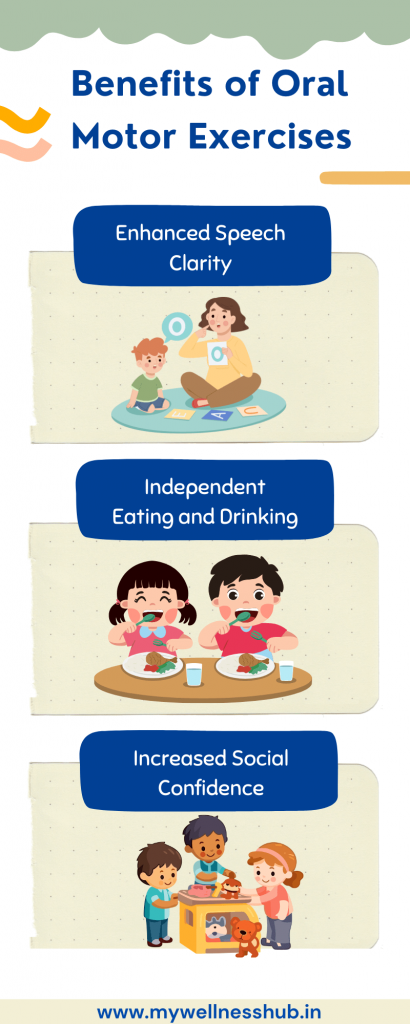Speech Clarity: The Key Goals of Oral Motor Exercises
Last Updated: May 22, 2024
The goals of Oral Motor Exercises focus on improving the precise movements required for talking and eating. These exercises are essential for anyone who struggles with speech and swallowing. By targeting the muscles that control the lips, tongue, and jaw, they help enhance speech clarity and ease of eating. This makes everyday communication and meal enjoyment much easier.
Also Read: Oral motor Exercises: Key to Better Speech
Understanding Oral Motor Exercises
Oral motor exercises might sound complicated, but they are really just simple, effective ways to make the muscles in your mouth work better. These exercises help with talking, swallowing, and other mouth functions.
So, what are these exercises exactly? They are special activities that make the mouth’s muscles stronger and better coordinated. This includes exercises like blowing, sucking, chewing, and different movements of the tongue, lips, and jaw. Each exercise is chosen to help with specific needs.
Who uses these exercises? A lot of people can benefit from them. This includes kids who are learning to talk and eat, adults who have trouble speaking because of things like a stroke or brain injury, and people with ongoing conditions like cerebral palsy or autism who might find basic mouth movements hard. They’re also really important for people who have trouble swallowing, to help them eat and drink safely without choking.
Also read: Unlocking Communication: Effective Speech Therapy for Autism
Primary Goals of Oral Motor Exercises
Oral motor exercises have clear goals: to make the muscles in your mouth stronger, better coordinated, and more effective. These exercises help improve how you speak and swallow safely. Let’s look at how they do this:

Strength and Muscle Tone
The main aim of these exercises is to make the muscles around your mouth stronger—the lips, tongue, and jaw. By doing exercises like blowing bubbles or chewing tough materials, these muscles get stronger over time. Strong lips can help you make sounds more clearly when you speak, and a strong tongue helps you speak more precisely and eat safely.
Coordination and Control
It’s also important for the mouth muscles to work well together. Exercise can help train your muscles to move smoothly and in sync when you talk or eat. For example, you might practice moving your tongue to different spots in your mouth or getting your lips to move right along with the sounds you make. These kinds of activities help you control your mouth movements better, which is key for speaking clearly and eating efficiently.
Speech Clarity and Swallowing
By making your muscles stronger and more coordinated, oral motor exercises help you speak more clearly. Good speech needs your mouth muscles to move just right, and these exercises help with that. They also make swallowing safer and easier by reducing the risk of choking. This is especially important for people who have trouble swallowing, making eating not just safer but more enjoyable too.
Common Oral Motor Exercises and Their Benefits
| Exercise | Target Area | Benefit |
|---|---|---|
| Blowing Bubbles | Lips | Improves breath control and lip strength |
| Tongue Stretching | Tongue | Increases tongue flexibility and mobility |
| Lip Presses | Lips | Strengthens lip muscles for better closure |
| Cheek Puffing | Cheeks | Enhances cheek muscle tone and control |
| Straw Drinking | Lips, Tongue | Improves sucking strength and coordination |
| Tongue Lateralization | Tongue | Promotes side-to-side tongue movements |
| Jaw Exercises | Jaw | Increases jaw strength and control |
Read more: Understanding Stuttering: Causes, Impact, & Treatment
Benefits of Oral Motor Exercises

Oral motor exercises are not just about improving how you talk and eat—they also boost your social life and self-confidence. Let’s see how these exercises can change daily life for the better:
Better Speaking Skills
Being able to communicate clearly is very important in our everyday interactions. Oral motor exercises help strengthen and coordinate the mouth muscles, making it easier to speak clearly. This isn’t just about talking louder but about sharing thoughts and feelings more effectively, making conversations more interesting and meaningful. For people with speech difficulties, these exercises can greatly improve how they express themselves, helping them to speak more clearly and confidently.
Safer and More Independent Eating and Drinking
Oral motor exercises also help with eating and drinking by making the mouth muscles stronger and more coordinated. This reduces the risk of choking, making eating and drinking safer. It makes meals more enjoyable, too, because people can eat more independently. Whether it’s a young child learning to eat solids or an adult getting better after a health issue, these exercises help them eat and drink more easily and safely.
More Confidence in Social Situations
Being able to speak clearly and eat easily can really boost someone’s confidence. People feel less worried about talking to others or eating in public if they know they can do it well. This means they can join in more freely and feel more relaxed in social situations, whether it’s chatting at a meal or giving a talk in front of others. These improvements help people feel more confident and less embarrassed, encouraging them to be more social and open with others.
Implementing Oral Motor Exercises in Therapy
Integrating oral motor exercises into therapy involves a thoughtful blend of science and personalized care. Each therapy session is carefully crafted to meet the unique needs of the individual, ensuring they receive the most effective treatment for enhancing their oral motor skills. Let’s take a closer look at what a typical therapy session might involve and how therapists tailor these exercises to individual needs.
A Typical Therapy Session
A standard session focusing on oral motor exercises usually begins with an assessment of the individual’s current abilities. The therapist might start by observing how the person speaks, eats, or manages saliva. Following this, the session typically involves a series of exercises tailored to target specific muscles or functions. These might include activities like blowing bubbles to strengthen the lips, using a straw for sucking exercises to enhance cheek and lip control or manipulating various textures of food to improve chewing and swallowing.
Therapists often use a variety of tools and techniques, such as whistles, straws, or therapeutic chewables, which are designed to engage and strengthen the oral muscles. Each activity is chosen based on its ability to meet the specific goals set out for the individual’s development.
Tailoring Exercises to Individual Needs
Understanding the unique needs of each individual is crucial for the success of oral motor therapy. Speech-language pathologists conduct thorough assessments that may include examining muscle tone, motor control, and coordination of the mouth. They consider factors such as age, underlying health conditions, and specific difficulties faced by the individual in their daily life.
Learn more: Best Speech Therapy Tips For Parents to Use at Home
Progress Tracking in Oral Motor Therapy
| Session Number | Exercises Performed | Improvements Noted | Therapist’s Notes |
|---|---|---|---|
| 1 | Blowing bubbles, Lip presses | Initial difficulty with lip closure noted | The Patient struggled initially but showed enthusiasm to learn. |
| 2 | Straw drinking, Tongue stretching | Better lip closure, slight tongue control | Improvement in lip strength; continue to encourage practice. |
| 3 | Cheek puffing, Jaw exercises | Cheek muscles are more responsive | Notable improvement in cheek control. Increase exercise complexity. |
| 4 | Tongue lateralization, Jaw exercises | Improved jaw stability, tongue movement | The Patient is making steady progress in tongue and jaw control. |
| 5 | All previous exercises combined | Clear speech articulation, effective swallowing | Significant improvements were noted in all areas. Ready for advanced exercises. |
Conclusion
Oral motor exercises have powerful benefits that can really change lives. These exercises help improve how clearly we speak, make eating and drinking safer, and boost our confidence in social situations. If you think these exercises could help you or someone you know, talking to a speech-language pathologist is a great first step. They can tailor the exercises to meet specific needs, helping everyone achieve better communication and more independence.
At Wellness Hub, our team is committed to giving each client personal attention and the best care possible. If you’re interested in learning more about how oral motor exercises can improve quality of life, or if you want to schedule a visit, check out our speech therapy services on our website. Remember, a small step today could lead to a big improvement in everyday life. Let’s work together towards clearer speech and safer eating.
Frequently Asked Questions:
1. What are oral motor exercises?
Oral motor exercises are specialized activities designed to strengthen and coordinate the muscles in the mouth, such as the lips, tongue, and jaw. These exercises are crucial for improving speech clarity and the ability to eat and drink safely.
2. Who can benefit from oral motor exercises?
Anyone experiencing difficulties with speech clarity, swallowing, or general muscle control in the mouth can benefit from oral motor exercises. This includes children developing their speech and eating skills, adults recovering from medical conditions, and individuals with speech impairments due to neurological issues.
3. How do oral motor exercises improve speech?
These exercises enhance the strength, flexibility, and coordination of the oral muscles, leading to clearer and more precise speech. This is achieved through targeted activities that train the muscles required for articulation and voice modulation.
4. Can oral motor exercises help with swallowing?
Yes, oral motor exercises can significantly improve swallowing safety by strengthening the muscles used during the process, enhancing coordination, and reducing the risk of choking, which is particularly beneficial for individuals with swallowing disorders.
5. What does a typical oral motor exercise therapy session look like?
A typical session involves an initial assessment by a speech-language pathologist, followed by targeted exercises tailored to the individual’s specific needs. These may include activities like blowing, sucking, and various tongue and lip exercises, often using tools like straws or therapeutic chewables.
6. How long does it take to see improvements from oral motor exercises?
The time it takes to observe improvements can vary widely depending on the individual’s initial condition, the specific exercises used, and the frequency of therapy. Generally, consistent practice is key to seeing progress.
7. Are there any tools or aids used during oral motor exercises?
Yes, tools such as straws, whistles, and therapeutic chewables may be used to assist in the exercises, helping to make the activities more effective and engaging.
8. Where can I find a professional for oral motor exercises?
Speech-language pathologists are the professionals who specialize in assessing and treating issues with speech and swallowing, including the implementation of oral motor exercises. You can consult with one at specialized clinics, hospitals, or private practices like Wellness Hub.
9. What are the signs that someone might need oral motor exercises?
Signs that might indicate the need for oral motor exercises include difficulty articulating words, frequent drooling or spilling of liquids from the mouth, challenges with chewing and swallowing food, or speech that is less clear compared to peers of the same age. If you notice these signs, consulting a speech-language pathologist could be beneficial.
10. Can oral motor exercises be done at home?
Yes, many oral motor exercises can be practiced at home under the guidance of a professional. A speech-language pathologist can provide specific exercises and instructions tailored to individual needs, ensuring that the exercises are performed safely and effectively. Regular practice at home can help accelerate progress alongside formal therapy sessions.
About the Author:
Anuradha Karanam
Speech-language pathologist (7+ years of experience)
Anuradha Karanam is a skilled speech-language pathologist with over 6 years of experience. Fluent in Tamil, Telugu, Hindi, and English, she specializes in parent counseling, speech sound disorders, fluency assessment, and speech-language evaluations. Anuradha excels at working with children with developmental disorders, offering creative and effective therapy programs. Currently, at Wellness Hub, she holds a BASLP degree and is registered with the RCI (CRR No A85500). Her patience, ambition, and dedication make her a trusted expert in her field. Connect with Anuradha to learn more about how she can help you or your loved one find their voice.
Book your Free Consultation Today
Parent/Caregiver Info:
Client’s Details:
* Error Message









